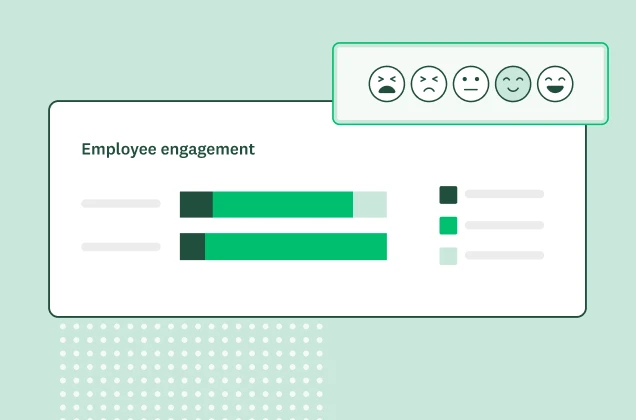How to engage remote employees: 7 strategies for success
Engage your remote employees for better productivity. Learn strategies to promote job satisfaction and employee retention in your remote workforce.

There is no better indicator of employees’ happiness, motivation, and commitment than employee engagement. Today, as 32.6 million Americans (nearly 22% of the workforce) prepare to work remotely by 2025, HR professionals have begun to focus on keeping their growing remote workforce engaged.
Engagement can be challenging in remote work scenarios due to the physical distance between teams. Utilizing an employee engagement program can help close important employee experience gaps, which can improve remote employee engagement. This article will share seven strategies for adding remote workers to your engagement program.
Why you should engage remote employees
Other reasons to engage remote employees include:
Increase job satisfaction and employee retention
Job satisfaction measures how fulfilled an employee feels in their current role. Increasing job satisfaction through an employee engagement program helps improve retention rates. This is because employees with high job satisfaction are more likely to stick around at a company.
Poor retention results in the need to rehire for roles frequently, which can significantly hinder your company’s budget.
Reduce churn costs
Low employee engagement also results in high churn costs. To lower customer churn, ensure remote employees feel valued, seen, and heard at work. Promoting employee engagement aids in improving customer retention and reducing marketing expenditures on replacing lost customers.
Boost productivity
When productivity is high, employees perform at their best and produce great work. This results in happier customers, less wasted time, and increased output. You can boost productivity by engaging remote employees using the strategies discussed in this article.
Build company culture
Company culture is essential to fostering a safe and healthy work environment for employees. When feeling engaged in their work, employees are more prone to developing a stronger company culture built on common values and shared goals.
Enhance customer loyalty
Enhancing customer loyalty is another reason to prioritize remote employee engagement for your HR team. When employees are engaged, productivity and positivity skyrocket, resulting in enjoyable customer experiences, on-time work, and increased revenue.

7 strategies for engaging remote employees
Now that we’ve discussed why engaging remote employees is crucial let’s explore some ideas for employee engagement.
Don’t put off checking in or sharing feedback until the annual review. HR teams and managers should be making time to regularly check in with employees to gauge their job satisfaction and level of engagement. There are various means by which to communicate and share feedback with employees, including:
- One-on-ones (1:1s) are a fantastic opportunity to share feedback and engage in conversations with employees. Whether these check-in calls are weekly, bi-weekly, or monthly, utilize the time to discuss any challenges an employee faces and ensure they feel heard.
- Team meetings are a great time to share updates about the team's progress toward a specific company goal or initiative. Use this channel to recognize employee contributions and celebrate accomplishments.
- Performance reviews share employee performance feedback over the past quarter. Managers should provide honest feedback and actionable steps for performance improvement. You can also use performance review surveys to boost job satisfaction and organizational growth.
Ask for (and listen to) employee feedback
Employee feedback is a precious resource for a company focused on growth. HR teams should collect employee feedback via employee feedback surveys regularly. Whether you send out a company survey monthly or quarterly, it will assist in building a better workplace.
When employees who work remotely see their ideas manifested within the organization, they’ll feel more connected to the company culture. They’ll also be encouraged to contribute more ways to increase employee engagement. Employees who think they’re making a difference in their jobs are more likely to see themselves having a future with the company.
Provide a robust benefits package
When employees feel adequately supported and cared for by their company, they are far more likely to remain engaged. Comprehensive benefits packages typically include:
- Health insurance
- Retirement plans
- Paid time off (PTO)
- Parental leave
- Life and disability insurance
- Professional development
- Health savings accounts (HSAs) or flexible spending accounts (FSAs)
Note that these are only expected benefits included in modern benefits packages, which vary from company to company.
HR teams can use online surveys to collect feedback on their current benefits plans and make adjustments. Use the SurveyMonkey compensation and benefits survey template to save time creating one from scratch.
Build an employee health and wellness program
Remote workers deserve the same health and wellness opportunities as in-person professionals. A health and wellness program ensures employees’ physical and mental health remains in peak condition. This is the key to happy, productive, and engaged employees.
Some ideas include running virtual yoga or mindfulness sessions or providing employees with gym memberships or vouchers for local fitness classes. Most importantly, you should clarify that you support employees’ mental health. This includes creating safe spaces to share their feelings, encouraging paid time off, and asking for feedback on your current employee benefits.
HR teams can also use surveys like this work-life balance survey template to gauge how employees feel about current health and wellness programs.
Build an employee recognition program
Providing recognition through an employee recognition program is one of the best ways to engage remote employees. These programs celebrate and highlight employees who have gone above and beyond for the company.
A recent study by SurveyMonkey revealed that 82% of employees are happier when they receive recognition at work. This stat is a testament to the true power of an employee recognition program.
Some rewards HR teams can offer in employee recognition programs include:
- Monetary bonuses
- Gift cards
- Extra PTO
- Physical gifts
- Trophies
Bolster communication channels
Communication channels for remote employees support enhanced collaboration and successful teamwork. Keeping clear, open communication channels is essential to keeping remote workers engaged. With open team communication, you can prevent bottlenecked tasks and employee frustration.
In today’s digital era, the various communication channels seem endless. Some of the common communication channels for remote teams include:
- Video communication: Video conferencing platforms such as Zoom, Microsoft Teams, and Google Meet are highly effective forms of digital communication. The ability to see facial expressions aids in better communication with fewer misunderstandings.
- Chat-based communication: Platforms like Slack provide instant communication with colleagues. Their communications are faster, more efficient, and more secure than email, and they integrate well with other communication tools you might be using.
- Email: Email has been an effective tool for workplace communication for many years and continues to be relevant. Employees can email company-wide notices, share documents and attachments with coworkers, and more.
- Company intranet or bulletin board: These internal communication tools are highly beneficial for sharing resources and updates with remote employees.
Along with collaboration and communication tools, it is vital to ensure employees understand how, where, and when to engage with their team members, managers, and team leaders.
Send employee care packages
Employee care packages can boost morale and demonstrate your appreciation for everyone at the company. Coordinate where to send employees’ packages with a contact information form and choose the items with intention.
Here are some examples of employee care packages:
- Company apparel: Company-branded clothing or swag is a great way to build pride among team members.
- Office supplies: Consider distributing office supplies your team may use frequently. You can also include fun extras like laptop stickers or portable chargers.
- Treats and snacks: Sending a box of treats can help recreate the delight of surprise office treats.
- Wellness kits: A wellness-focused employee care package might include a branded water bottle, blue light glasses, and exercise equipment.
Remember, employee engagement initiatives aren’t as simple as a one-and-done team-building activity or employee care package. Employee engagement is an ongoing initiative that should be measured, tracked, and analyzed—which is easy to do with employee engagement surveys.
Boost employee engagement and productivity with SurveyMonkey
SurveyMonkey works to improve remote employee engagement by gathering employee feedback to inform your efforts to boost morale and build company culture.
Learn how SurveyMonkey can help you improve employee engagement and productivity today.
Discover more resources

HR toolkit: Make employee experience your competitive advantage
HR leaders can use this toolkit to help drive exceptional employee experiences.

Get started quickly with SurveyMonkey for HR, marketing, and market research pros
How professionals in HR, market research, and marketing can start using surveys--fast.

Employee forms: use cases and templates
Learn how to use employee forms to improve essential HR processes, boost employee experience, and drive change. Discover best practices for creating your own employee forms.

From insights to impact: Leveraging curiosity to build more inclusive workplaces
A discussion at how to create a more equitable workplace.